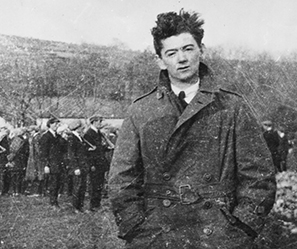100 YEARS AGO: The Crossbarry ambush
Published in Issue 2 (March/April 2021), Volume 29By Joseph E.A. Connell Jr

Above: IRA commander Tom Barry—he only became aware of the danger of encirclement at Crossbarry at the last minute and resolved to fight his way out. (Meda Ryan/Mercier Press)
The Crossbarry ambush occurred on 19 March 1921 and was one of the largest engagements of the War of Independence. It took place at the rural crossroads of Crossbarry, Co. Cork, about 20km south-west of Cork city. The IRA escaped a major British attempt to surround them. During the hour-long battle, between ten and 40 British troops and three–six IRA Volunteers were killed.
On the days before, the British army began amassing troops near Crossbarry. The engagement began as a huge encircling operation by the Crown forces, involving the Hampshire Regiment (from Cork), the Essex Regiment (Bandon and Kinsale) and Auxiliaries (from Macroom)—approximately 1,120 seasoned troops facing about 100 IRA Volunteers.
The IRA commander, Tom Barry, only became aware of the danger at the last minute and decided that his men would have to fight their way out of the encirclement. Barry’s calculation was that his men, who had only 40 rounds each, could not sustain the all-day fight that they could expect if they retired before the British. He observed, however, that one of the British columns advancing towards Crossbarry was well ahead of the other enemy units. If his men could break through this British force, roughly the same strength as his own, they could break out of the encirclement.
Barry laid an ambush for the British at Crossbarry crossroads, his men being in position by 5.30am. When the first British lorries reached Crossbarry—about twelve vehicles according to Barry’s account—they were caught by surprise and hit by crossfire at very close range. The British took significant casualties and many of them fled the scene. Barry’s men collected the British arms and ammunition before setting fire to the lorries. At this point they were attacked again by another British column of about 200, coming from the south-west, but these retired after a stiff firefight. Two more British units converging on the area from the south-east tried to dislodge the IRA from their ambush position but again without success, and they, too, retired in disorder.
Seizing the chance offered by his quick victory to get away, Barry then marched his men to safety in the Gurranereigh area, while the British were still disoriented by the ambush. There was another brief exchange of fire at long range as the IRA column got away. The action had lasted for under an hour. On realising what had happened, Major Percival of the Essex Regiment rushed to the scene with his troops, but was only able to open long-range fire on the fleeing IRA men. He later blamed the failure of the British operation on the Auxiliary column that had gone to the wrong rendezvous point and had therefore left a gap in the encirclement. There were some further firefights along the IRA column’s line of retreat but with no further casualties on either side.
Barry’s account does not mention the use of the explosives, but contemporary press accounts reported that a roadside mine planted under the bridge at Crossbarry was detonated as the British passed, destroying three of their lorries.
From the beginning of the fighting Florence Begley, the brigade piper, played martial airs on his war pipes in Harold’s farmyard and continued to play while the firing lasted. Volunteers who fought at Crossbarry spoke later of how the piper spurred them on to greater effort. Tom Kelleher often said that ‘that man’s music was more effective than twenty rifles’. The piper also had an effect on the morale of the British troops. They would have associated a piper with a battalion in their army, and consequently would have thought that there were many more IRA Volunteers present than there really were. Liam Deasy wrote that ‘this was Begley’s finest hour’.
Joseph E.A. Connell Jr is the author of The shadow war: Michael Collins and the politics of violence (Eastwood Books).
















